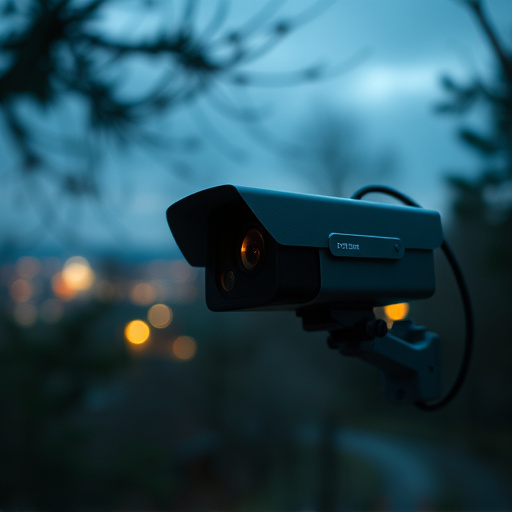Electromagnetic signals, including infrared (IR), are crucial for modern surveillance, like invisible IR cameras used in home monitoring. Understanding these signals helps optimize camera placement to minimize interference from household devices, enhancing security. Homeowners can protect their privacy by detecting IR cameras using specialized equipment and strategically placing cameras hidden from view with minimal external glow. Regular maintenance ensures reliable operation. EMI shields and signal jammers disrupt camera function, providing enhanced privacy in the digital era.
In an era where privacy is increasingly at a premium, understanding how to detect surveillance devices, especially invisible IR cameras, is crucial for home monitoring. This comprehensive guide delves into the world of electromagnetic signal detection, providing practical tips for discreetly identifying and countering these covert devices. From recognizing infrared camera presence to enhancing signal visibility, learn effective strategies to protect your personal space in today’s digital landscape, ensuring a safer and more secure environment at home.
- Understanding Electromagnetic Signals in Surveillance
- Detecting Invisible IR Camera Presence
- Home Monitoring: Tips for Discreet Detection
- Enhancing Signal Visibility: Practical Techniques
- Preventing and Countering Surveillance Measures
Understanding Electromagnetic Signals in Surveillance
Electromagnetic signals are an integral part of modern surveillance, especially with the advent of advanced technologies like invisible IR cameras for home monitoring. These signals, often referred to as electromagnetic radiation, include a wide range of frequencies from radio waves to infrared (IR) and visible light. Understanding these signals is crucial in effective surveillance device selection and deployment.
In the context of home monitoring, Invisible IR Cameras employ infrared radiation to capture images in low-light conditions or complete darkness. This is made possible by IR LEDs that emit light outside the visible spectrum, which human eyes cannot detect. By understanding electromagnetic signals, users can optimize camera placement, ensuring maximum coverage and minimal interference from other electronic devices, thereby enhancing overall surveillance capabilities.
Detecting Invisible IR Camera Presence
In the realm of home monitoring, detecting invisible IR camera presence is a crucial aspect of privacy protection. Infrared (IR) cameras, often used for security purposes, emit signals that are beyond human visible light perception. However, these signals can be detected using specialized equipment and techniques designed to uncover covert surveillance devices. Homeowners concerned about their privacy should consider employing electromagnetic signal detection tools, which can pinpoint the location of IR cameras hidden within homes.
By understanding how IR technology operates, individuals can stay ahead of potential intruders. These cameras capture heat signatures, making them particularly effective in low-light conditions. Therefore, it’s essential to be aware that they may emit subtle electromagnetic signals that can be harnessed for detection. With the right equipment and knowledge, homeowners can ensure their privacy by identifying and neutralizing invisible IR camera presence in their living spaces.
Home Monitoring: Tips for Discreet Detection
When it comes to home monitoring, discretion is key. If you’re looking for an invisible IR camera for a covert surveillance solution, consider these tips for discreet detection. Placement is crucial; mount or hide cameras in strategic locations where they can capture clear images but remain out of sight. Utilise reflective surfaces and shadows to bounce light away from the device, making it less noticeable. Additionally, ensure the camera’s infrared illumination is directed towards the target area rather than outward, reducing its glow and potential alert other occupants.
Regular maintenance and updates are essential for keeping your home monitoring system effective. Keep an eye on battery life and storage capacity to avoid any interruptions in surveillance. Test your device periodically, ensuring it captures high-quality images and video without detection. By maintaining a low profile and staying ahead of potential issues, you can rely on your invisible IR camera for reliable and discreet home monitoring.
Enhancing Signal Visibility: Practical Techniques
To enhance signal visibility for an Invisible IR Camera in home monitoring, several practical techniques can be employed. One approach is to minimize electromagnetic interference (EMI) from household appliances and electronics. Since EMI can weaken or obscure signals, positioning the camera away from sources like microwaves, cordless phones, and smart meters can significantly improve detection accuracy. Additionally, using shielded cables for connections can help prevent signal degradation caused by external electromagnetic noise.
Another effective method is to optimize the camera’s settings. Adjusting sensitivity levels, frame rates, and gain parameters ensures that weak signals are captured more effectively. Utilizing specialized filters designed for infrared technology further enhances signal visibility by allowing only relevant wavelengths through while blocking others, thereby reducing background noise. This, in conjunction with a well-placed Invisible IR Camera in home monitoring, can lead to clearer images and improved security.
Preventing and Countering Surveillance Measures
Surveillance devices, such as invisible IR cameras used for home monitoring, have advanced significantly in recent years. While they offer valuable peace of mind, it’s crucial to understand that these tools can be countered. One effective strategy is to employ electromagnetic signal detection techniques. By identifying and blocking the unique signals emitted by these surveillance devices, individuals can enhance their privacy.
For instance, using electromagnetic interference (EMI) shields or signal jammers designed to disrupt specific frequencies can prevent invisible IR cameras from capturing images. Additionally, keeping electronic appliances in close proximity to the camera’s lens can interfere with its operation. This DIY approach not only prevents unauthorized surveillance but also underscores the importance of being proactive in protecting personal spaces and data privacy in today’s digital age.
In today’s world of advanced surveillance technology, staying aware and protected is essential. By understanding electromagnetic signals and employing discreet monitoring techniques, like detecting invisible IR cameras, individuals can safeguard their privacy at home. These tips empower folks to navigate the digital landscape, ensuring a more secure environment without sacrificing convenience. Remember that knowledge is power when it comes to countering sophisticated surveillance measures.
